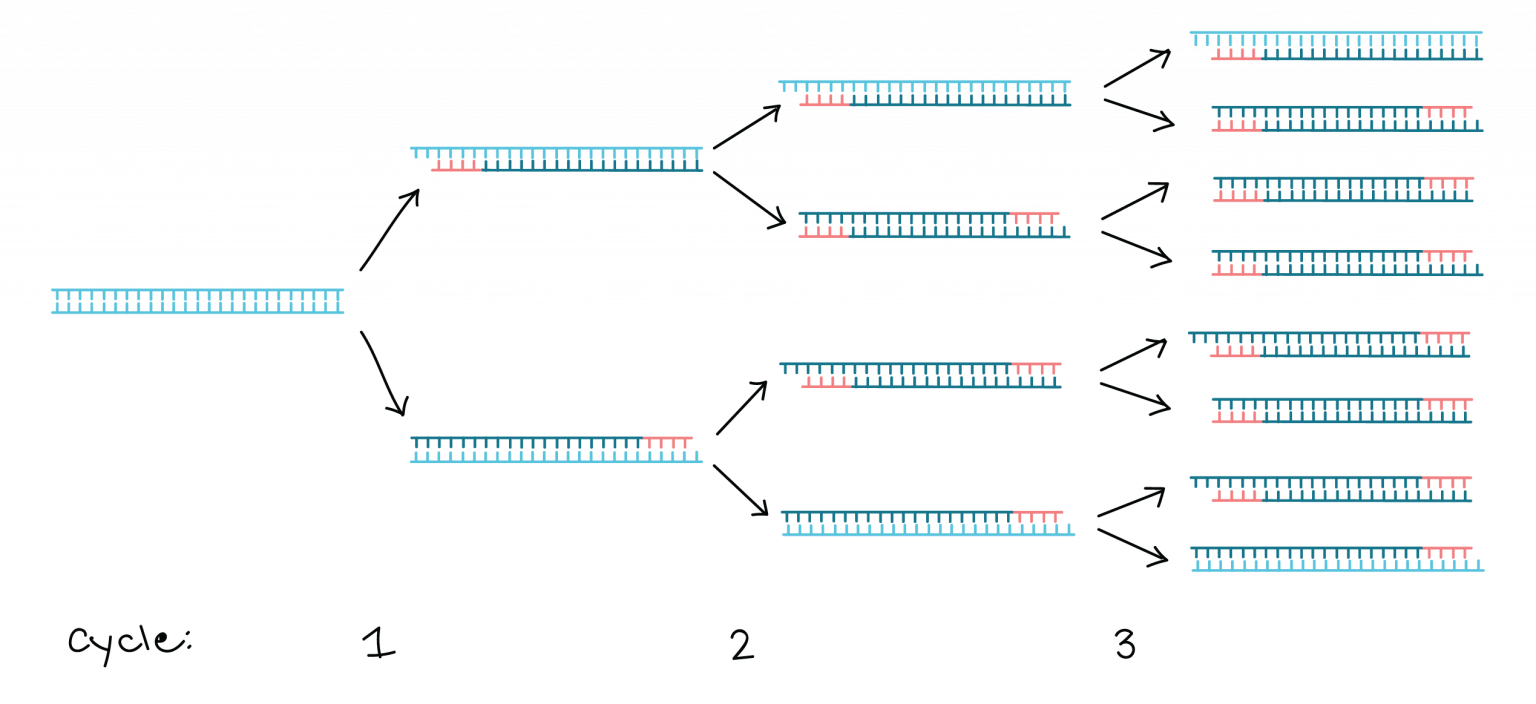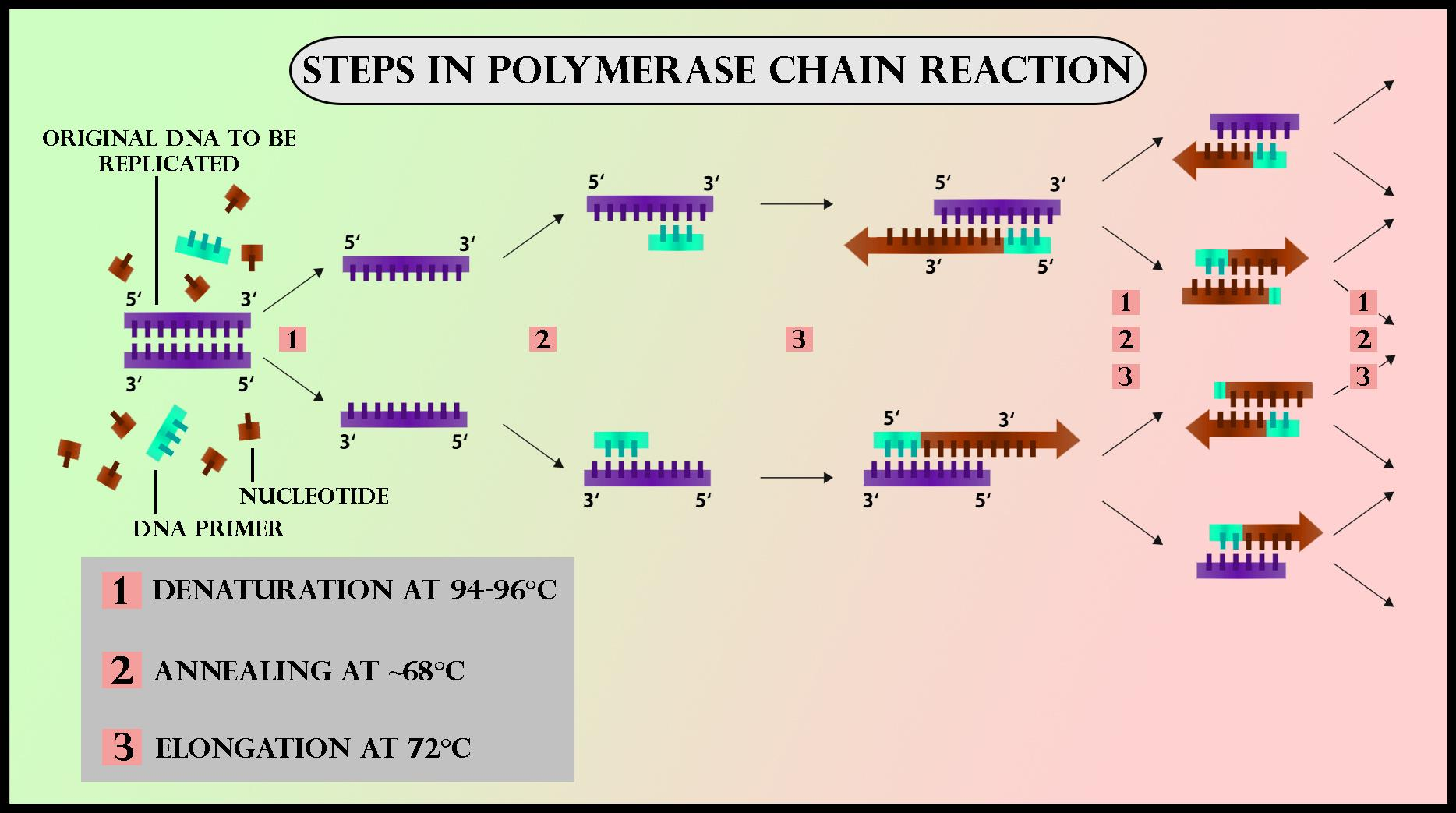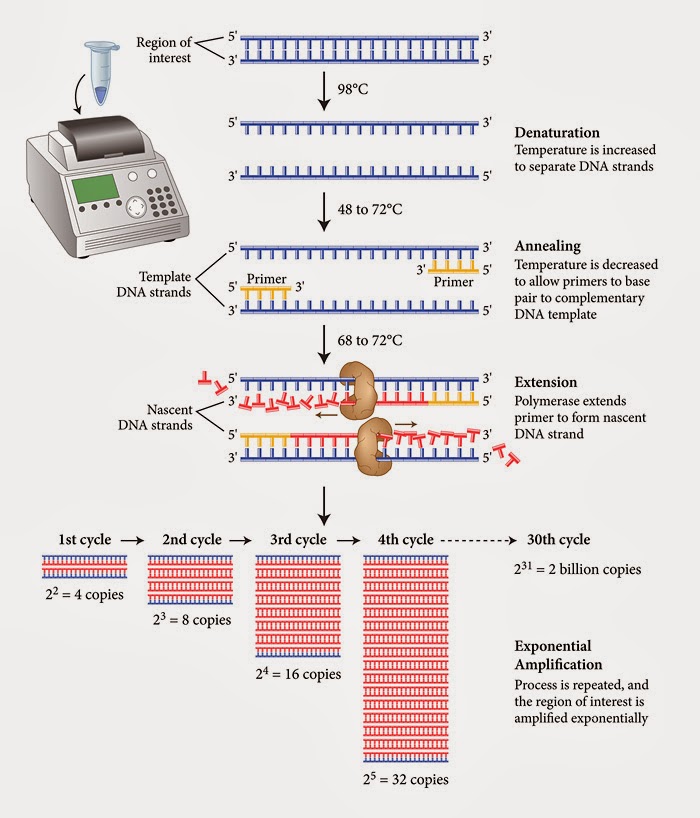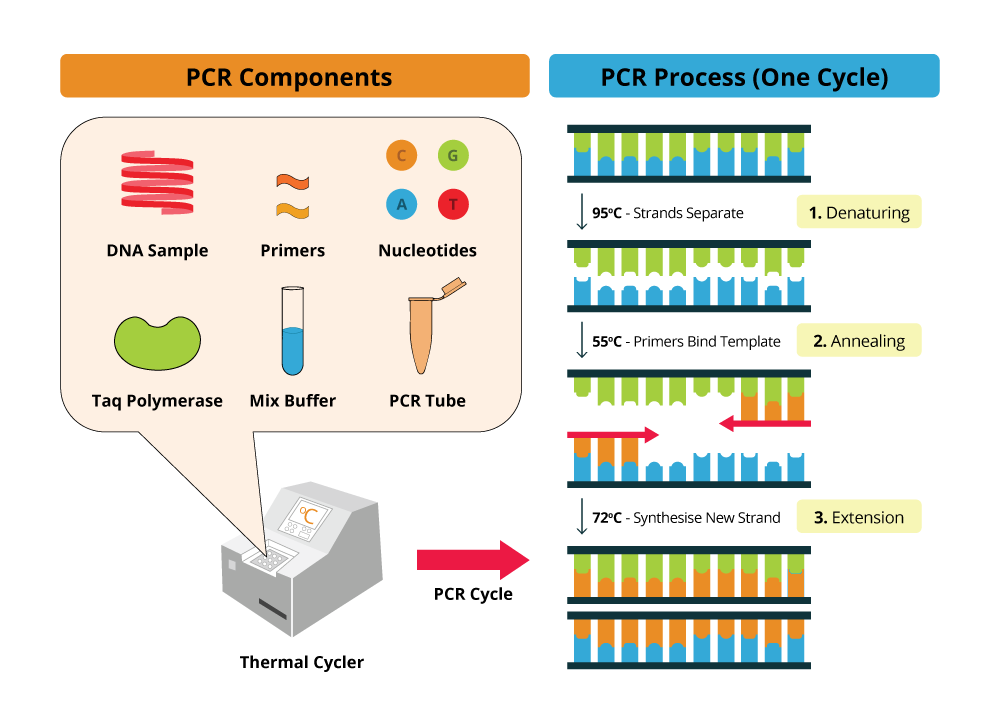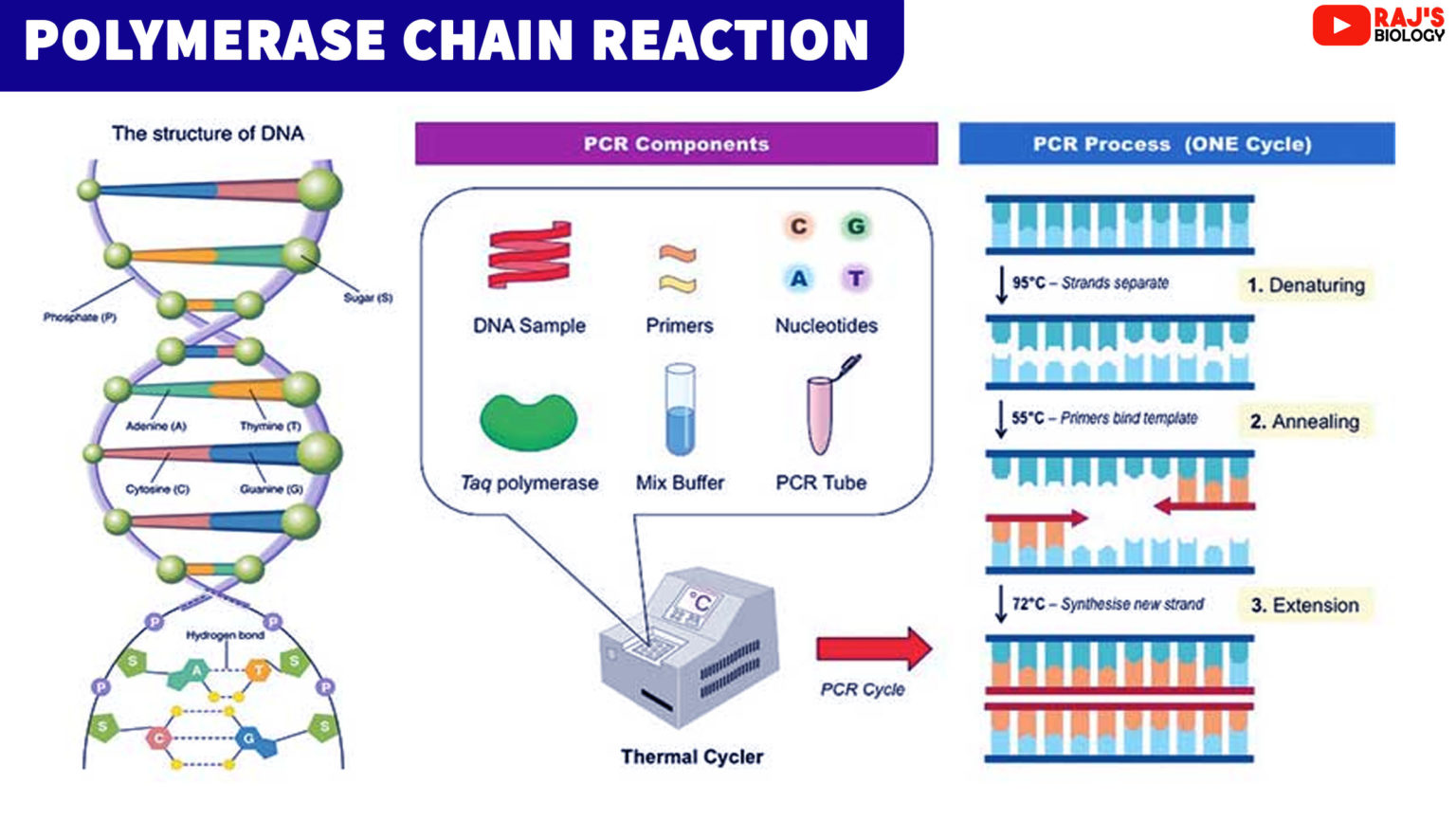What Is The Template Of The Pcr - Web pcr or polymerase chain reaction is a technique used in molecular biology to create several copies of a certain dna segment. Polymerase chain reaction a rapid technique for in vitro. Web template dna a pcr template for replication can be of any dna source, such as genomic dna (gdna), complementary dna (cdna), and plasmid dna. Pcr is based on using the ability. Web the polymerase chain reaction (pcr) is the bedrock of molecular biology and refers to a procedure whereby a known sequence of. Web the pcr machine increases and decreases the temperature of the sample in automatic, programmed steps. Web total rna or mrna is first transcribed into complementary dna (cdna). Web the pcr technique is based on the natural processes a cell uses to replicate a new dna strand. Web a standard polymerase chain reaction (pcr) setup consists of four steps: The cdna is then used as the template for the quantitative pcr or real.
Polymerase Chain Reaction (PCR) Definition, Steps, Principle, Application
Web the main components of pcr are a template, primers, free nucleotide bases, and the dna polymerase enzyme. The cdna is then used as the template for the quantitative pcr or real. Web language links are at the top of the page across from the title. Web polymerase chain reaction (pcr) is a technique used to amplify small segments of.
Polymerase chain reaction (PCR) template DNA and dsRNA. (A) Diagram
Web the main components of pcr are a template, primers, free nucleotide bases, and the dna polymerase enzyme. Web introduction pcr (polymerase chain reaction) is a revolutionary method developed by kary mullis in the 1980s. Web the pcr machine increases and decreases the temperature of the sample in automatic, programmed steps. Web dna template in pcr coding strand coding strand.
What are the properties of PCR (template) DNA? Education
Web the pcr technique is based on the natural processes a cell uses to replicate a new dna strand. Web as pcr progresses, the dna generated is itself used as a template for replication, setting in motion a chain reaction in which the original dna template is. Add required reagents or mastermix and template to. Web total rna or mrna.
Draw a neat labelled diagram showing steps of PCR class 12 biology CBSE
Polymerase chain reaction a rapid technique for in vitro. Web introduction pcr (polymerase chain reaction) is a revolutionary method developed by kary mullis in the 1980s. Add required reagents or mastermix and template to. Web a standard polymerase chain reaction (pcr) setup consists of four steps: The cdna is then used as the template for the quantitative pcr or real.
Fun with Biotechnology PCR
Web these are typically short, single stranded oligonucleotideswhich are complementary to the outer regions of known sequence. Web a standard polymerase chain reaction (pcr) is an in vitro method that allows a single, short region of a dna molecule (single gene perhaps) to be copied. Web the pcr machine increases and decreases the temperature of the sample in automatic, programmed.
PCR process (With images) Dna, Dna drawing, Primer design
Web these are typically short, single stranded oligonucleotideswhich are complementary to the outer regions of known sequence. Web introduction pcr (polymerase chain reaction) is a revolutionary method developed by kary mullis in the 1980s. Web the main components of pcr are a template, primers, free nucleotide bases, and the dna polymerase enzyme. Web as pcr progresses, the dna generated is.
Polymerase Chain Reaction (PCR) Key Principles
Web dna template in pcr coding strand coding strand vs template strand lesson summary frequently asked questions what is the template strand of dna?. Web polymerase chain reaction (pcr) is a technique used to amplify small segments of dna. Add required reagents or mastermix and template to. Web total rna or mrna is first transcribed into complementary dna (cdna). Web.
Types of PCR Common Kinds of Polymerase Chain Reaction BioMadam
The cdna is then used as the template for the quantitative pcr or real. Web pcr or polymerase chain reaction is a technique used in molecular biology to create several copies of a certain dna segment. Polymerase chain reaction a rapid technique for in vitro. Web a standard polymerase chain reaction (pcr) is an in vitro method that allows a.
Polymerase Chain Reaction Notes Rajus Biology
Web template dna a pcr template for replication can be of any dna source, such as genomic dna (gdna), complementary dna (cdna), and plasmid dna. Web a standard polymerase chain reaction (pcr) setup consists of four steps: Web the polymerase chain reaction (pcr) is the bedrock of molecular biology and refers to a procedure whereby a known sequence of. Web.
Overview of the polymerase chain reaction (PCR). Template DNA strands
Web language links are at the top of the page across from the title. Web pcr or polymerase chain reaction is a technique used in molecular biology to create several copies of a certain dna segment. Web as pcr progresses, the dna generated is itself used as a template for replication, setting in motion a chain reaction in which the.
Web the polymerase chain reaction (pcr) is the bedrock of molecular biology and refers to a procedure whereby a known sequence of. Web a standard polymerase chain reaction (pcr) is an in vitro method that allows a single, short region of a dna molecule (single gene perhaps) to be copied. Web as pcr progresses, the dna generated is itself used as a template for replication, setting in motion a chain reaction in which the original dna template is. Web pcr or polymerase chain reaction is a technique used in molecular biology to create several copies of a certain dna segment. Web the main components of pcr are a template, primers, free nucleotide bases, and the dna polymerase enzyme. The cdna is then used as the template for the quantitative pcr or real. Web these are typically short, single stranded oligonucleotideswhich are complementary to the outer regions of known sequence. Web the pcr technique is based on the natural processes a cell uses to replicate a new dna strand. Web dna template in pcr coding strand coding strand vs template strand lesson summary frequently asked questions what is the template strand of dna?. Polymerase chain reaction a rapid technique for in vitro. Web the pcr machine increases and decreases the temperature of the sample in automatic, programmed steps. Web introduction pcr (polymerase chain reaction) is a revolutionary method developed by kary mullis in the 1980s. Web pcr (polymerase chain reaction) tests are a fast, highly accurate way to diagnose certain infectious diseases and genetic changes. Web template dna a pcr template for replication can be of any dna source, such as genomic dna (gdna), complementary dna (cdna), and plasmid dna. Add required reagents or mastermix and template to. Web total rna or mrna is first transcribed into complementary dna (cdna). Pcr is based on using the ability. Web a standard polymerase chain reaction (pcr) setup consists of four steps: Web polymerase chain reaction (pcr) is a technique used to amplify small segments of dna. Web language links are at the top of the page across from the title.
Polymerase Chain Reaction A Rapid Technique For In Vitro.
Pcr is based on using the ability. Web these are typically short, single stranded oligonucleotideswhich are complementary to the outer regions of known sequence. Web a standard polymerase chain reaction (pcr) is an in vitro method that allows a single, short region of a dna molecule (single gene perhaps) to be copied. Web dna template in pcr coding strand coding strand vs template strand lesson summary frequently asked questions what is the template strand of dna?.
Web Language Links Are At The Top Of The Page Across From The Title.
Web polymerase chain reaction (pcr) is a technique used to amplify small segments of dna. Web as pcr progresses, the dna generated is itself used as a template for replication, setting in motion a chain reaction in which the original dna template is. Web the polymerase chain reaction (pcr) is the bedrock of molecular biology and refers to a procedure whereby a known sequence of. Web template dna a pcr template for replication can be of any dna source, such as genomic dna (gdna), complementary dna (cdna), and plasmid dna.
Add Required Reagents Or Mastermix And Template To.
Web the pcr machine increases and decreases the temperature of the sample in automatic, programmed steps. Web introduction pcr (polymerase chain reaction) is a revolutionary method developed by kary mullis in the 1980s. Web a standard polymerase chain reaction (pcr) setup consists of four steps: The cdna is then used as the template for the quantitative pcr or real.
Web Total Rna Or Mrna Is First Transcribed Into Complementary Dna (Cdna).
Web pcr or polymerase chain reaction is a technique used in molecular biology to create several copies of a certain dna segment. Web pcr (polymerase chain reaction) tests are a fast, highly accurate way to diagnose certain infectious diseases and genetic changes. Web the main components of pcr are a template, primers, free nucleotide bases, and the dna polymerase enzyme. Web the pcr technique is based on the natural processes a cell uses to replicate a new dna strand.

